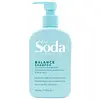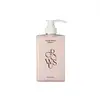What's inside
What's inside
 Key Ingredients
Key Ingredients

 Benefits
Benefits

 Concerns
Concerns

 Ingredients Side-by-side
Ingredients Side-by-side

Water
Skin ConditioningSodium Coco-Sulfate
CleansingCoco-Glucoside
CleansingLauryl Betaine
CleansingGlyceryl Oleate
EmollientBetaine
HumectantSodium Chloride
MaskingHydroxypropyl Guar Hydroxypropyltrimonium Chloride
Parfum
MaskingKaolin
AbrasiveInulin
Skin ConditioningPEG-12 Dimethicone
Skin ConditioningCitric Acid
BufferingGlycol Distearate
EmollientPyridoxine Hcl
Skin ConditioningGlycerin
HumectantAloe Barbadensis Leaf Juice
Skin ConditioningNiacinamide
SmoothingPanthenol
Skin ConditioningHydrolyzed Yeast Protein
Skin ConditioningThreonine
Allantoin
Skin ConditioningBiotin
AntiseborrhoeicPhenoxyethanol
PreservativeSodium Benzoate
MaskingPotassium Sorbate
PreservativeHexyl Cinnamal
PerfumingWater, Sodium Coco-Sulfate, Coco-Glucoside, Lauryl Betaine, Glyceryl Oleate, Betaine, Sodium Chloride, Hydroxypropyl Guar Hydroxypropyltrimonium Chloride, Parfum, Kaolin, Inulin, PEG-12 Dimethicone, Citric Acid, Glycol Distearate, Pyridoxine Hcl, Glycerin, Aloe Barbadensis Leaf Juice, Niacinamide, Panthenol, Hydrolyzed Yeast Protein, Threonine, Allantoin, Biotin, Phenoxyethanol, Sodium Benzoate, Potassium Sorbate, Hexyl Cinnamal
Water
Skin ConditioningDisodium Laureth Sulfosuccinate
CleansingGlycerin
HumectantSodium Cocoyl Isethionate
CleansingDisodium Cocoamphodiacetate
CleansingLauryl Hydroxysultaine
CleansingSodium Chloride
MaskingCocamide Mipa
EmulsifyingGlycol Distearate
EmollientParfum
MaskingPolyquaternium-10
Sodium Methyl Cocoyl Taurate
CleansingCaprylyl Glycol
EmollientArginine
MaskingCarbomer
Emulsion StabilisingSalicylic Acid
MaskingPanthenol
Skin ConditioningHexylene Glycol
EmulsifyingDisodium EDTA
Niacinamide
SmoothingSea Water
HumectantDipropylene Glycol
HumectantButylene Glycol
HumectantGlyceryl Caprylate
EmollientGardenia Florida Fruit Extract
Skin Conditioning1,2-Hexanediol
Skin ConditioningBifida Ferment Lysate
Skin ConditioningDextrin
AbsorbentLactobacillus/Eriodictyon Californicum Ferment Extract
Skin ConditioningCamellia Japonica Leaf Extract
Skin ConditioningCeratonia Siliqua Fruit Extract
MaskingDiospyros Kaki Fruit Extract
Skin ConditioningEnteromorpha Compressa Extract
Skin ProtectingGelidium Cartilagineum Extract
Skin ProtectingLaminaria Japonica Extract
Skin ProtectingSpirulina Platensis Extract
Skin ProtectingUndaria Pinnatifida Extract
Skin ConditioningMilk Protein Extract
Hydrolyzed Collagen
EmollientHydrolyzed Barley Protein
Skin ConditioningHydrolyzed Corn Protein
Skin ConditioningHydrolyzed Keratin
HumectantHydrolyzed Soy Protein
HumectantBiotin
AntiseborrhoeicCollagen Extract
Skin ConditioningHizikia Fusiforme Extract
Skin ConditioningPearl Extract
AntioxidantSaccharomyces Ferment Filtrate
HumectantSaccharomyces/Coix Lacryma-Jobi Ma-Yuen Seed Ferment Filtrate
Skin ConditioningSaccharomyces/Rice Ferment Filtrate
Skin ConditioningTetrasodium EDTA
Ethylhexylglycerin
Skin ConditioningHelianthus Annuus Seed Oil
EmollientHydrogenated Lecithin
EmulsifyingCeramide NP
Skin ConditioningCollagen
MoisturisingCollagen Amino Acids
MoisturisingSoluble Collagen
HumectantSoluble Collagen Crosspolymer
EmollientZinc Hydrolyzed Collagen
Skin ConditioningPhytosphingosine
Skin ConditioningCitronellol
PerfumingGeraniol
PerfumingLinalool
PerfumingWater, Disodium Laureth Sulfosuccinate, Glycerin, Sodium Cocoyl Isethionate, Disodium Cocoamphodiacetate, Lauryl Hydroxysultaine, Sodium Chloride, Cocamide Mipa, Glycol Distearate, Parfum, Polyquaternium-10, Sodium Methyl Cocoyl Taurate, Caprylyl Glycol, Arginine, Carbomer, Salicylic Acid, Panthenol, Hexylene Glycol, Disodium EDTA, Niacinamide, Sea Water, Dipropylene Glycol, Butylene Glycol, Glyceryl Caprylate, Gardenia Florida Fruit Extract, 1,2-Hexanediol, Bifida Ferment Lysate, Dextrin, Lactobacillus/Eriodictyon Californicum Ferment Extract, Camellia Japonica Leaf Extract, Ceratonia Siliqua Fruit Extract, Diospyros Kaki Fruit Extract, Enteromorpha Compressa Extract, Gelidium Cartilagineum Extract, Laminaria Japonica Extract, Spirulina Platensis Extract, Undaria Pinnatifida Extract, Milk Protein Extract, Hydrolyzed Collagen, Hydrolyzed Barley Protein, Hydrolyzed Corn Protein, Hydrolyzed Keratin, Hydrolyzed Soy Protein, Biotin, Collagen Extract, Hizikia Fusiforme Extract, Pearl Extract, Saccharomyces Ferment Filtrate, Saccharomyces/Coix Lacryma-Jobi Ma-Yuen Seed Ferment Filtrate, Saccharomyces/Rice Ferment Filtrate, Tetrasodium EDTA, Ethylhexylglycerin, Helianthus Annuus Seed Oil, Hydrogenated Lecithin, Ceramide NP, Collagen, Collagen Amino Acids, Soluble Collagen, Soluble Collagen Crosspolymer, Zinc Hydrolyzed Collagen, Phytosphingosine, Citronellol, Geraniol, Linalool
Ingredients Explained
These ingredients are found in both products.
Ingredients higher up in an ingredient list are typically present in a larger amount.
Biotin is a B vitamin that is naturally produced by our bodies. It is also called Vitamin H.
Our bodies use biotin in the metabolism process. It also helps our bodies use enzymes and move nutrients around. A biotin deficiency can lead to brittle hair and nails.
More research is needed on applying biotin topically. However, taking biotin orally has been shown to help nourish the skin, hair, and nails. They play a role in forming skin-hydrating fatty acids.
Biotin is water-soluble. It can be found in foods such as fish, eggs, dairy, nuts, and meat. Vitamin H stands for "haar" and "haut". These are the German words for hair and skin.
Learn more about BiotinGlycerin is already naturally found in your skin. It helps moisturize and protect your skin.
A study from 2016 found glycerin to be more effective as a humectant than AHAs and hyaluronic acid.
As a humectant, it helps the skin stay hydrated by pulling moisture to your skin. The low molecular weight of glycerin allows it to pull moisture into the deeper layers of your skin.
Hydrated skin improves your skin barrier; Your skin barrier helps protect against irritants and bacteria.
Glycerin has also been found to have antimicrobial and antiviral properties. Due to these properties, glycerin is often used in wound and burn treatments.
In cosmetics, glycerin is usually derived from plants such as soybean or palm. However, it can also be sourced from animals, such as tallow or animal fat.
This ingredient is organic, colorless, odorless, and non-toxic.
Glycerin is the name for this ingredient in American English. British English uses Glycerol/Glycerine.
Learn more about GlycerinGlycol Distearate serves as a pearlizing or opacifying agent in cosmetic products.
It's often included in cleansers and haircare products to give them a lustrous or shimmering appearance.
It is derived from stearic acid, a natural fatty acid commonly found in vegetable oils and animal fats.
Glycol Distearate isn't fungal acne safe.
Learn more about Glycol DistearateNiacinamide is a multitasking form of vitamin B3 that strengthens the skin barrier, reduces pores and dark spots, regulates oil, and improves signs of aging.
And the best part? It's gentle and well-tolerated by most skin types, including sensitive and reactive skin.
You might have heard of "niacin flush", or the reddening of skin that causes itchiness. Niacinamide has not been found to cause this.
In very rare cases, some individuals may not be able to tolerate niacinamide at all or experience an allergic reaction to it.
If you are experiencing flaking, irritation, and dryness with this ingredient, be sure to double check all your products as this ingredient can be found in all categories of skincare.
When incorporating niacinamide into your routine, look out for concentration amounts. Typically, 5% niacinamide provides benefits such as fading dark spots. However, if you have sensitive skin, it is better to begin with a smaller concentration.
When you apply niacinamide to your skin, your body converts it into nicotinamide adenine dinucleotide (NAD). NAD is an essential coenzyme that is already found in your cells as "fuel" and powers countless biological processes.
In your skin, NAD helps repair cell damage, produce new healthy cells, support collagen production, strengthen the skin barrier, and fight environmental stressors (like UV and pollution).
Our natural NAD levels start to decline with age, leading to slower skin repair, visible aging, and a weaker skin barrier. By providing your skin niacinamide, you're recharging your skin's NAD levels. This leads to stronger, healthier, and younger looking skin.
Another name for vitamin B3 is nicotinamide. This vitamin is water-soluble and our bodies don't store it. We obtain Vitamin B3 from either food or skincare. Meat, fish, wheat, yeast, and leafy greens contain vitamin B3.
The type of niacinamide used in skincare is synthetically created.
Learn more about NiacinamidePanthenol is a common ingredient that helps hydrate and soothe the skin. It is found naturally in our skin and hair.
There are two forms of panthenol: D and L.
D-panthenol is also known as dexpanthenol. Most cosmetics use dexpanthenol or a mixture of D and L-panthenol.
Panthenol is famous due to its ability to go deeper into the skin's layers. Using this ingredient has numerous pros (and no cons):
Like hyaluronic acid, panthenol is a humectant. Humectants are able to bind and hold large amounts of water to keep skin hydrated.
This ingredient works well for wound healing. It works by increasing tissue in the wound and helps close open wounds.
Once oxidized, panthenol converts to pantothenic acid. Panthothenic acid is found in all living cells.
This ingredient is also referred to as pro-vitamin B5.
Learn more about PanthenolParfum is a catch-all term for an ingredient or more that is used to give a scent to products.
Also called "fragrance", this ingredient can be a blend of hundreds of chemicals or plant oils. This means every product with "fragrance" or "parfum" in the ingredients list is a different mixture.
For instance, Habanolide is a proprietary trade name for a specific aroma chemical. When used as a fragrance ingredient in cosmetics, most aroma chemicals fall under the broad labeling category of “FRAGRANCE” or “PARFUM” according to EU and US regulations.
The term 'parfum' or 'fragrance' is not regulated in many countries. In many cases, it is up to the brand to define this term.
For instance, many brands choose to label themselves as "fragrance-free" because they are not using synthetic fragrances. However, their products may still contain ingredients such as essential oils that are considered a fragrance by INCI standards.
One example is Calendula flower extract. Calendula is an essential oil that still imparts a scent or 'fragrance'.
Depending on the blend, the ingredients in the mixture can cause allergies and sensitivities on the skin. Some ingredients that are known EU allergens include linalool and citronellol.
Parfum can also be used to mask or cover an unpleasant scent.
The bottom line is: not all fragrances/parfum/ingredients are created equally. If you are worried about fragrances, we recommend taking a closer look at an ingredient. And of course, we always recommend speaking with a professional.
Learn more about ParfumChances are, you eat sodium chloride every day. Sodium Chloride is also known as table salt.
This ingredient has many purposes in skincare: thickener, emulsifier, and exfoliator.
You'll most likely find this ingredient in cleansers where it is used to create a gel-like texture. As an emulsifier, it also prevents ingredients from separating.
There is much debate on whether this ingredient is comedogenic. The short answer - comedogenic ratings don't tell the whole story. Learn more about comegodenic ratings here.
The concensus about this ingredient causing acne seems to be divided. Research is needed to understand if this ingredient does cause acne.
Scrubs may use salt as the primary exfoliating ingredient.
Learn more about Sodium ChlorideWater. It's the most common cosmetic ingredient of all. You'll usually see it at the top of ingredient lists, meaning that it makes up the largest part of the product.
So why is it so popular? Water most often acts as a solvent - this means that it helps dissolve other ingredients into the formulation.
You'll also recognize water as that liquid we all need to stay alive. If you see this, drink a glass of water. Stay hydrated!
Learn more about Water